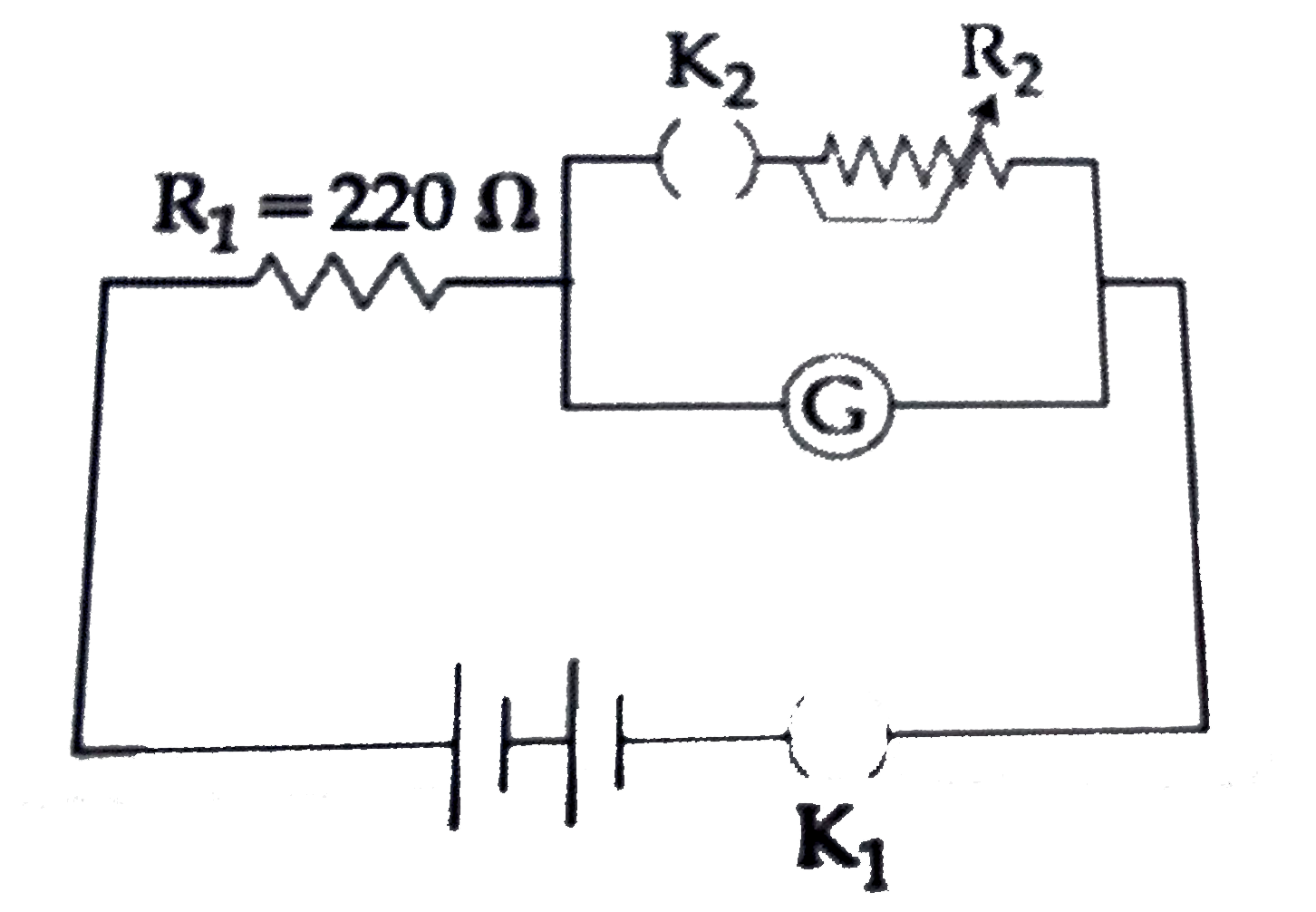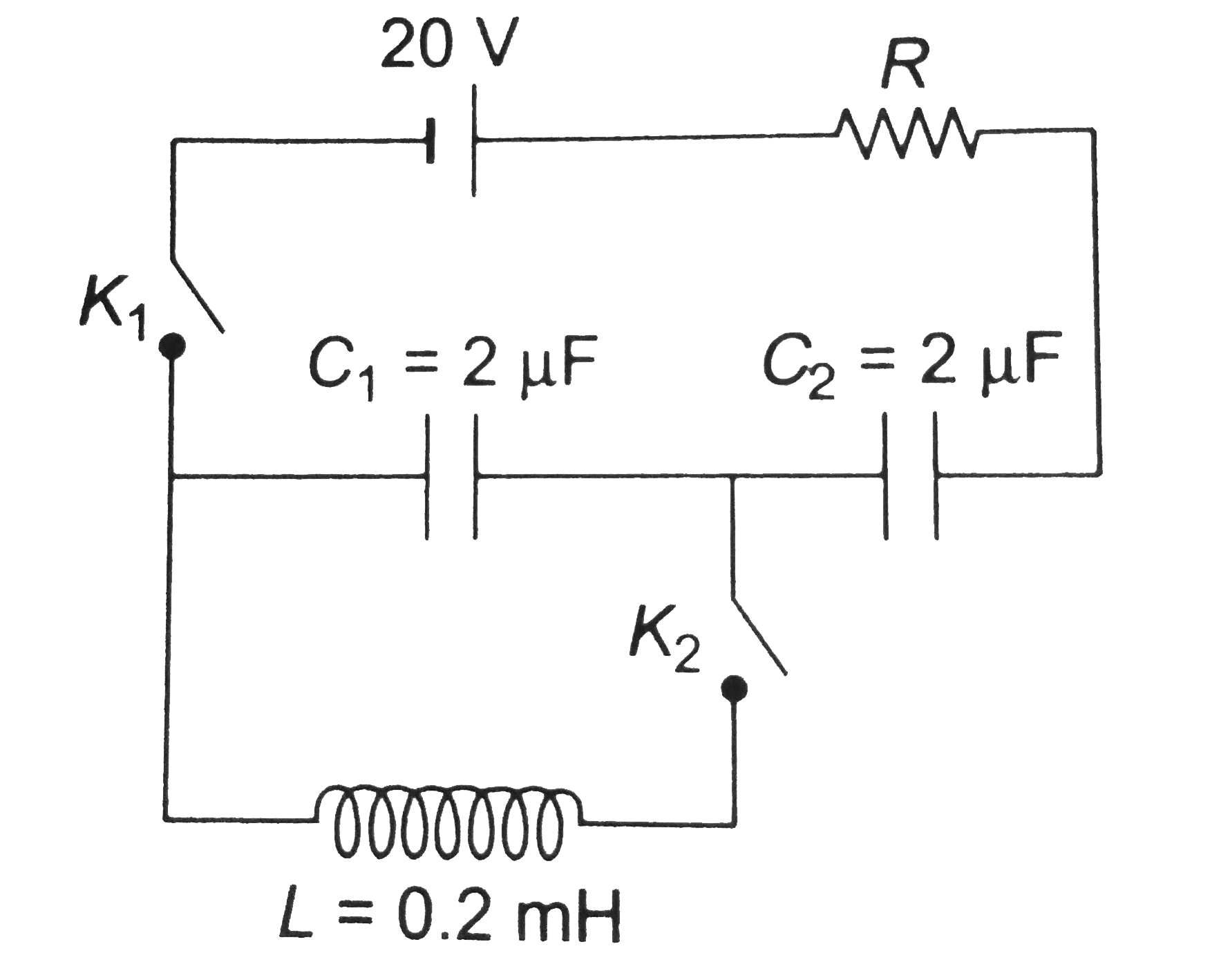Assertion To locate null defiection the battery key (K1) is pressed first and then the galvanom eter key (K2)
Reason if first K2 is pressed and then as soon as K1 is pressed current suddenly try to increase so due to self induction a large stopping emf is generated in galvanometer which may damage the glavanometer .
A. if both Asseration and Reason are true and the Reason is a correct explation of Asseration
B. if both Asseration and Reason are true and the Reason is a correct explation of Asseration
C. if Asseration is ture but Reason is false
D. If both Assertion and Reason are false
The correct Answer is:A
To solve the question regarding the assertion and reason about the operation of a galvanometer and the keys involved, we can break it down into a step-by-step explanation:
Step 1: Understand the Assertion
The assertion states that to locate the null deflection in a galvanometer, the battery key K1 should be pressed first, followed by the galvanometer key K2. This means that the battery should be connected to the circuit before the galvanometer is activated.
Step 2: Understand the Reason
The reason provided explains that if the galvanometer key K2 is pressed first, and then the battery key K1 is pressed, the current will suddenly try to increase. This sudden change in current can induce a large back electromotive force (emf) in the galvanometer due to self-induction, which can potentially damage the galvanometer.
Step 3: Analyze the Circuit
1. Circuit Components: The circuit consists of a battery (with key K1) and a galvanometer (with key K2).
2. Inductance of the Galvanometer: The galvanometer has an inductance L, which means it can oppose changes in current due to self-induction.
Step 4: Explain the Process
1. Pressing K1 First: When K1 is pressed first, the battery is connected, and the circuit is powered. The galvanometer is still open (not connected), so there is no current flowing through it.
2. Pressing K2 Second: When K2 is pressed after K1, the galvanometer is connected to the circuit where a steady current is already established. This allows the galvanometer to measure the current without experiencing a sudden change, thus avoiding damage.
3. If K2 is Pressed First: If K2 is pressed first, the galvanometer will initially have zero current. When K1 is pressed, the sudden increase in current will induce a back emf in the galvanometer due to its inductance. According to Lenz's law, this back emf will oppose the change in current, causing a significant deflection in the galvanometer pointer, which can lead to damage.
Step 5: Conclusion
Both the assertion and reason are true, and the reason correctly explains why the assertion is necessary. Therefore, the correct conclusion is that pressing K1 before K2 is essential to prevent damage to the galvanometer.
Final Answer
Both the assertion and reason are true, and the reason is a correct explanation of the assertion.
---
The assertion states that to locate the null deflection in a galvanometer, the battery key K1 should be pressed first, followed by the galvanometer key K2. This means that the battery should be connected to the circuit before the galvanometer is activated.
The reason provided explains that if the galvanometer key K2 is pressed first, and then the battery key K1 is pressed, the current will suddenly try to increase. This sudden change in current can induce a large back electromotive force (emf) in the galvanometer due to self-induction, which can potentially damage the galvanometer.
1. Circuit Components: The circuit consists of a battery (with key K1) and a galvanometer (with key K2).
2. Inductance of the Galvanometer: The galvanometer has an inductance L, which means it can oppose changes in current due to self-induction.
1. Pressing K1 First: When K1 is pressed first, the battery is connected, and the circuit is powered. The galvanometer is still open (not connected), so there is no current flowing through it.
2. Pressing K2 Second: When K2 is pressed after K1, the galvanometer is connected to the circuit where a steady current is already established. This allows the galvanometer to measure the current without experiencing a sudden change, thus avoiding damage.
3. If K2 is Pressed First: If K2 is pressed first, the galvanometer will initially have zero current. When K1 is pressed, the sudden increase in current will induce a back emf in the galvanometer due to its inductance. According to Lenz's law, this back emf will oppose the change in current, causing a significant deflection in the galvanometer pointer, which can lead to damage.
Both the assertion and reason are true, and the reason correctly explains why the assertion is necessary. Therefore, the correct conclusion is that pressing K1 before K2 is essential to prevent damage to the galvanometer.
Both the assertion and reason are true, and the reason is a correct explanation of the assertion.
Topper's Solved these Questions
- EXPERIMENTAL PHYSICSBOOK - RESONANCE ENGLISHCHAPTER - EXPERIMENTAL PHYSICSEXERCISE - Exercise
12 Videos
- EXPERIMENTAL PHYSICSBOOK - RESONANCE ENGLISHCHAPTER - EXPERIMENTAL PHYSICSEXERCISE - Exercise -1 PART
1 Videos
- ELECTROSTATICSBOOK - RESONANCE ENGLISHCHAPTER - ELECTROSTATICSEXERCISE - HLP
40 Videos
- GEOMATRICAL OPTICS BOOK - RESONANCE ENGLISHCHAPTER - GEOMATRICAL OPTICS EXERCISE - Advance level Problems
35 Videos
Similar Questions
To locate null point, deflection battery key K1 is pressed before the galvanometer key K2. Explain why?
View SolutionTo locate null point deflection battery key (K1) ios pressed before the galvanometer (K2) Explanation why?
View SolutionIn the given circuit, calculate the ratio of currents through the battery if (1) Key K1 is pressed, K2 open and then (2) Key K2 is pressed, key K1 is opened

View SolutionIn the circuit given in tigure, 1 and 2 are ammeters. Just after key K is pressed to complete the circuit the reading will be
View SolutionThe galvanometer deflection , when key K1 is closed but K2 is open equals θ0 (see figure ) On closing k2 also and adjusting R2 to 5Ω , the deflection in galvanometer becomes θ05 the resistnce of the galvanometer is then , given by [Neglect the internal resistance of battery]:

View SolutionA circuit containing capacitors C1 and C2, shown in the figure is in the steady state with key K1 and K2 opened. At the instant t=0, K1 is opened and K2 is closed.

(a) Find the angular frequency of oscillations of L−C circuit.
(b) Determine the first instant t, when energy in the inductor becomes one third of that in the capacitor.
(c) Calculate the charge on the plates of the capacitor at that instant.
View SolutionB1,B2andB3 are the three identical bulbs connected to a battery of steady emf with key K closed. What happens to the brightness of the bulbs B1 and B2 when the key is opened?

View SolutionTwo inductors of self inductances L1andL2 and of resistances R1andR2 (not shown) respectively are conneted in the circuit as shown. At the instant t = 0, key k is closed. Obtain an expression for which the galvanometer will show zero deflection at all times after the key is closed.
View SolutionAssertion:− The dissocation constant of poly basic acid are in order K1>K2>K3.
Reason:− The H+ ion furnished in first step of dissocation exert common ion effect to reduce the second dissociation and soon.
View SolutionA thermocol vessel contains 0.5kg of distilled water at 30∘C. A metal coil of area 5×10−3m2, number of turns 100, mass 0.06kg and resistance 1.6Ω is lying horizontally at the bottom of the vessel. A uniform time-varying magnetic field is set up to pass vertically through the coil at time t=0. The field is first increased from zero to 0.8T at a constant rate between 0 and 0.2s and then decreased to zero at the same rate between 0.2and0.4s. the cycle is repeated 12000 times. Make sketches of the current through the coil and the power dissipated in the coil as function of time for the first two cycles. Clearly indicate the magnitude of the quantities on the axes. Assumes that no heat is lost to the vessel or the surroundings. Determine the final tempreture of water under thermal equilibrium. Specific heat of metal =500jkg−1K−1 and the specific heat of water =4200jkg−1K−1. Neglect the inductance of coil.
View Solution
